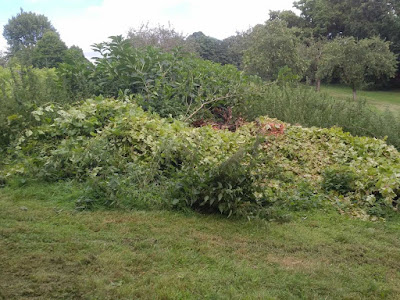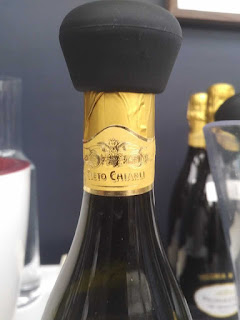 |
| Left block looking neat |
OK, Fun in the Vineyard, 3rd episode as promised. This started well but ended how shall we say, not so well. The gorgeous weather in the first half of summer was a bit too much for a few young vines which expired with the heat and lack of irrigation (we can't be there all the time}. On the plus side, the grass and weeds practically stopped growing which gace us the chance to make things look neat and tidy.
 |
| blooming Ramisco |
Even so we had to dig lots of new holes so we hired this Auger - a machine for boring fence holes. Just the job.
 |
| awaiting planting |
White
Acadie Blanc x4
Aurore x 3
Madeleine Sylvaner x 4
Ortega x 1
Raeuschling x 2
Red
Abouriou x 3
Alvarelhao x 4
Cabernet Cortis x 3
Chambourcin x 1
Croatina x 1
Gagarin Blue x 2
Gamay x 3
Grignolino x 12
Jurancon Noir x 2
Krasnostop Zolotavskiy x 1
Muscat Bleu x 2
Persan x 3
Petit Rouge x 1
Pineau D'Aunis x 1
Poulsard x 2
Ramisco x 7
Although all advice said to keep them in their pots over the winter and plant them out next spring, we decided to plant most of them in the autumn as we had no place to keep them and their holes had been dug. A farmer of our acquaintance said it should be OK provided they didn't dry out and the second half of the summer as well as the autumn so far ensured that would not happen.
 |
| all gone to their new homes |
 |
| apart from this dozen |
 |
| Alvarelhao with attempted fruit set |
Meanwhile, here are a few we have incorporated into the left block. If they succeed there, they will succeed anywhere.
Why are we pessimistic about the Left Block?
The clay in this part of the vineyard is more unforgiving than elsewhere. Drainage is a problem and vines don't like wet feet. We call it the Experimental Vineyard. We're not really expecting many of the vines we have planted to survive and of those that do, most will not bear ripe fruit even in a record heatwave year. If just one variety is vigorous enough to prevail, we will be happy.
 | ||
| mystery grape |
 |
| before |
Kindred
Microthiol
Filan
Stroby
Karamate
Phyte P Plus
This seemed to be working well until the mid point of the growing season when spots of mildew appeared. Perhaps we had got the dosage wrong? We found it hard to deduct what to put into a 15 litre spray backpack when the dose is based on Kilos per hectare.
 |
| prunings from 1 vine only |
 |
| after |
 |
| masses of prunings, maybe too much. |
 |
| underage Gamay with precocious grapes |
 |
| promising Bacchus |
 |
| promising Triomphe |
 |
| one for the birds |
 |
| another for the birds, and not the last |
Mildew increased apace from then on, affecting perhaps half the Bacchus and to a lesser extent the Goldriesling grapes. Of the remaining half, the birds took 50% before we had a chance to harvest them, so we ended up with only 25% which made just 24 litres of juice.
 |
| clap hands and this was what happened - almost |
We caught the birds at it by the way: Pheasants, no less. They must taste rather interesting.
So what will we do next year? We'll try to eliminate grass and weeds around the vines this time. How to do that without using herbicides such as Round Up or spending a fortune to import a tractor fitted with an attachment to plough between the vines remains to be seen.
We'll adjust the dosage of chemicals to get it right this time and spray with Sulphur between the 10 chemical sprays if possible. The Ahr Valley, Germany's most northerly vineyard is sprayed with sulphur on a weekly basis.
We will also have to get to the grapes as soon as the birds start to show interest. Hopefully that is a good indication of ripeness.



























